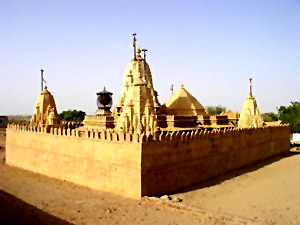 The city of Lodurva is an important historical center of Rajasthan. It is situated at a distance of 16 kilometers from Jaisalmer. Once upon a time it was the capital city of the Bhattis. Due to frequent invasions by Mahmud of Ghazni and Mohammad Ghori the capital had to be shifted to Jaisalmer. The city is dotted with Jain temples. The presence of these temples show the impact Jainism had on the people of Lodurva. Jain temples are well known for their elegance and artistry. These too are a treat to watch. Built in pale golden coloured stone of Jaisalmer the Jain temples in Rajasthan are uniquely carved.
The city of Lodurva is an important historical center of Rajasthan. It is situated at a distance of 16 kilometers from Jaisalmer. Once upon a time it was the capital city of the Bhattis. Due to frequent invasions by Mahmud of Ghazni and Mohammad Ghori the capital had to be shifted to Jaisalmer. The city is dotted with Jain temples. The presence of these temples show the impact Jainism had on the people of Lodurva. Jain temples are well known for their elegance and artistry. These too are a treat to watch. Built in pale golden coloured stone of Jaisalmer the Jain temples in Rajasthan are uniquely carved.
The Parshvanath Temple, Rishabhnath Temple and Shambhavanath Temple are worth the tourists` visits. Kalpavriksha is also a popular sightseeing. The Parshvanath Temple is a masterpiece of architectural grandeur. The ornate archway or the toran is attention grabbing with its exquisite carvings. The temple is a dedicated house the idol of 23rd Tirthankara, Lord Parsvanath built in blackstone and a multi-hooded serpent canopy is also built. The temple was destroyed in 1152 AD but it was later renovated by Seth Tharu Shah in the year 1615. The main image is surrounded by several fine sculptures.
Within the temple premises of Parshvanath Temple one will also come across the Kalpavriksha or Celestial Tree. Today the tree is no longer here. Instead life size sculpture of the tree is placed here. This sculpture is made out of eight alloys and is called an eternal tree. It represents enlightenment. It is said that the copper leaves have the miraculous power of granting wishes. On the outer walls of the temple there is a small carving. This is supposed to be the dwelling place for a black cobra. It is believed to be 400 years old. The devotees believe that it comes out of its cave in summer and anyone who catches a glimpse of it is showered with good fortune.
Rishabhnath Temple is located near Moomal. The temple was built on a commission by an affluent Marwari trader Seth Sachcha and was built in the year 1479. Rishabhnath is considered the first Jain Tirthankara ands is often found to have similarities with the Hindu god, Shiva. He is also mentioned in the Jain Holy book, Kalpa Sutra.
Shambhavanath Temple is dedicated to another important Jain Tirthankara, Lord Shambhavnath. The symbol for this saint is horse. The structure of the temple is primarily an octagonal pyramidal roof. The massive walls of the temple signify that the Jain devotees were anxious about the fact that their religious site can be harmed by the other groups. Besides the principal deity small temples are also built in niches that are dedicated to different Jain saints.





















